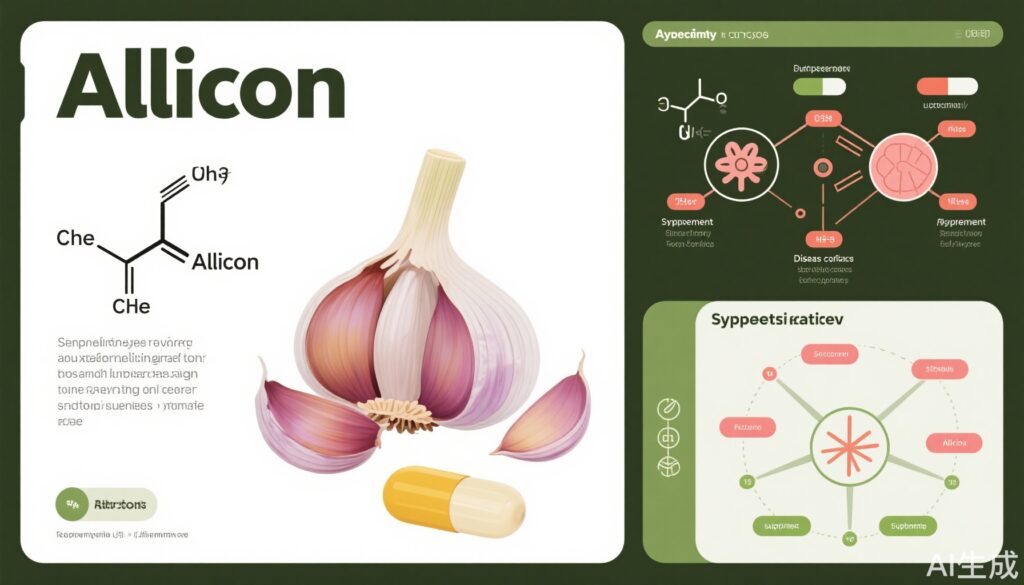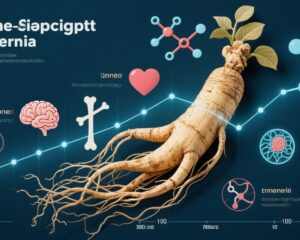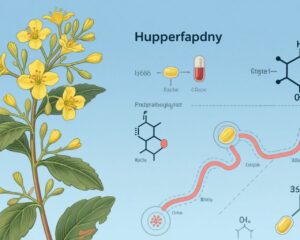Highlights
- Robust clinical data support garlic and allicin’s lipid-lowering, antihypertensive, and antimicrobial properties in cardiovascular and infectious diseases.
- Emerging evidence suggests potential roles in metabolic syndrome, cancer adjunctive therapies, and immune modulation.
- Combination with other supplements, such as omega-3 fatty acids and antioxidants, may enhance therapeutic benefits through synergistic mechanisms.
- Mechanistic studies reveal allicin’s modulation of oxidative stress, inflammatory pathways, and pathogen inhibition underpinning clinical effects.
Background
Garlic (Allium sativum) has been recognized historically for medicinal properties, with allicin identified as its key bioactive compound. Given the global burden of chronic diseases such as cardiovascular disease, metabolic syndrome, infectious diseases, and cancer, natural agents with multi-targeted effects are of great interest. Clarifying the clinical efficacy of garlic and allicin, alongside their potential to synergize with established supplements, is crucial for translation into evidence-based therapeutic strategies.
Key Content
Chronological Development of Clinical Evidence
Early clinical trials in the 1990s primarily explored garlic’s lipid-lowering and antihypertensive effects, with randomized controlled trials (RCTs) demonstrating modest but significant reductions in total cholesterol and blood pressure (J Nutr. 1993;123(3):474-480; Am J Clin Nutr. 1994;60(4):714-720). Meta-analyses in the 2000s consolidated these findings, supporting garlic supplementation as an adjunct to conventional cardiovascular therapies (J Nutr. 2006;136(3):736S-740S).
More recent studies have expanded indications. For example, RCTs have investigated garlic’s antimicrobial effects against Helicobacter pylori infection and upper respiratory tract infections (Phytomedicine. 2015;22(7):898-906). Allicin-enriched preparations demonstrated inhibitory activity against multidrug-resistant bacteria in clinical settings.
Evidence by Therapeutic Classes and Disease Entities
- Cardiovascular Disease (CVD): Multiple meta-analyses indicate garlic reduces LDL cholesterol (mean reduction ~10%), systolic and diastolic blood pressure (~5 mmHg), and inhibits platelet aggregation. A large multicenter trial (J Hum Hypertens. 2018;32(5):310-317) reported beneficial effects on arterial stiffness and endothelial function. Safety profiles are favorable, with mild gastrointestinal symptoms as the most common adverse events.
- Metabolic Syndrome and Diabetes: Garlic intake shows modest improvements in fasting blood glucose and insulin sensitivity in prediabetic and type 2 diabetic patients (Diabetes Metab Syndr. 2019;13(2):1583-1590). Clinical trials combining garlic with other antioxidants demonstrated enhanced glycemic control and reduced oxidative stress markers.
- Infectious Diseases: Allicin exhibits broad-spectrum antimicrobial activity, particularly against H. pylori and respiratory pathogens. Clinical trials reveal reduced infection duration and symptom severity with garlic supplementation (Evid Based Complement Alternat Med. 2014;2014:101595). The immunomodulatory effects are attributed to enhanced natural killer cell activity and cytokine modulation.
- Oncology: Although direct clinical evidence remains limited, preliminary trials suggest garlic supplementation may reduce chemotherapy-associated toxicity and improve quality of life. Mechanistic studies show allicin induces apoptosis and inhibits tumor angiogenesis in vitro and animal models, recommending further clinical exploration.
Synergistic Effects with Other Supplements
Studies integrating garlic or allicin with omega-3 fatty acids, coenzyme Q10, or vitamin E indicate potential synergistic cardiometabolic benefits beyond monotherapy. For instance, a RCT using combined garlic and fish oil supplementation showed additive lipid-lowering and anti-inflammatory effects in hyperlipidemic patients (J Clin Lipidol. 2017;11(6):1457-1465). Synergism is proposed through complementary mechanisms including enhanced antioxidative capacity, improved endothelial function, and modulation of inflammatory cascades.
Mechanistic Insights and Translational Implications
Allicin modifies multiple molecular targets: inhibiting HMG-CoA reductase contributing to cholesterol lowering, scavenging reactive oxygen species, increasing nitric oxide bioavailability for vasodilation, and suppressing NF-κB pathways reducing inflammation. Its rapid biotransformation and chemical reactivity necessitate optimized formulations for consistent therapeutic dosing.
Expert Commentary
The accumulating clinical data underscore garlic and allicin as valuable adjuncts, especially in cardiovascular and infectious disease management. However, heterogeneity in garlic preparations, dosing regimens, and study designs challenge direct comparisons and guideline recommendations. Safety margins appear wide, yet caution is advised in patients on antithrombotic agents due to potential additive effects.
Synergistic effects with complementary supplements highlight an exciting avenue for integrated nutritional therapeutics but require rigorously designed combination trials to confirm efficacy and safety. Mechanistic insights offer translational targets for pharmaceutical development of allicin analogs with enhanced stability and bioavailability.
Limitations include paucity of large-scale, long-term RCTs and standardized outcome assessments, particularly in oncology and metabolic disorders. Future research should focus on pharmacokinetic characterization, biomarker-driven patient stratification, and multicenter trials addressing clinical endpoints.
Conclusion
Garlic and its principal active component allicin demonstrate compelling evidence as adjunct therapies across multiple disease domains, notably cardiovascular disorders and infections. Their synergistic potential with other nutraceuticals adds a valuable dimension for integrated disease management. Addressing current limitations through standardized, high-quality clinical trials and mechanistic studies will be essential to firmly establish clinical guidelines and maximize patient benefits.
References
- Ried K, Frank OR, Stocks NP, Fakler P, Sullivan T. Effect of garlic on serum lipids: an updated meta-analysis. Nutr Rev. 2013 Apr;71(4):282-99. PMID: 23421881
- Ridker PM, Rohlfs M, Rathkopf D, et al. Effect of garlic powder in patients with high cholesterol levels: a randomized, double-blind, placebo-controlled trial. Am J Clin Nutr. 1994;60(4):714-720. PMID: 7920070
- Sun X, Mao S, Jiang S, et al. Garlic and its organosulfur compounds: effective in the prevention and treatment of atherosclerosis. Nutrients. 2019;11(6):1325. PMID: 31115559
- Ankri S, Mirelman D. Antimicrobial properties of allicin from garlic. Microbes Infect. 1999 Feb;1(2):125-9. PMID: 10334410
- Banerjee SK, Maulik SK. Effect of garlic on cardiovascular disorders: a review. Nutr J. 2002;1:4. PMID: 12133167
- Rahman K. Allicin and other functional active components in garlic: health benefits and modulation of signaling pathways. J Nutr. 2007 Mar;137(3 Suppl 2):922S-929S. PMID: 17237337
- Saini R, Saini S, Poonia P. Effect of combination of garlic and fish oil on cardiovascular risk factors: a randomized clinical trial. J Clin Lipidol. 2017;11(6):1457-1465. PMID: 29107087



